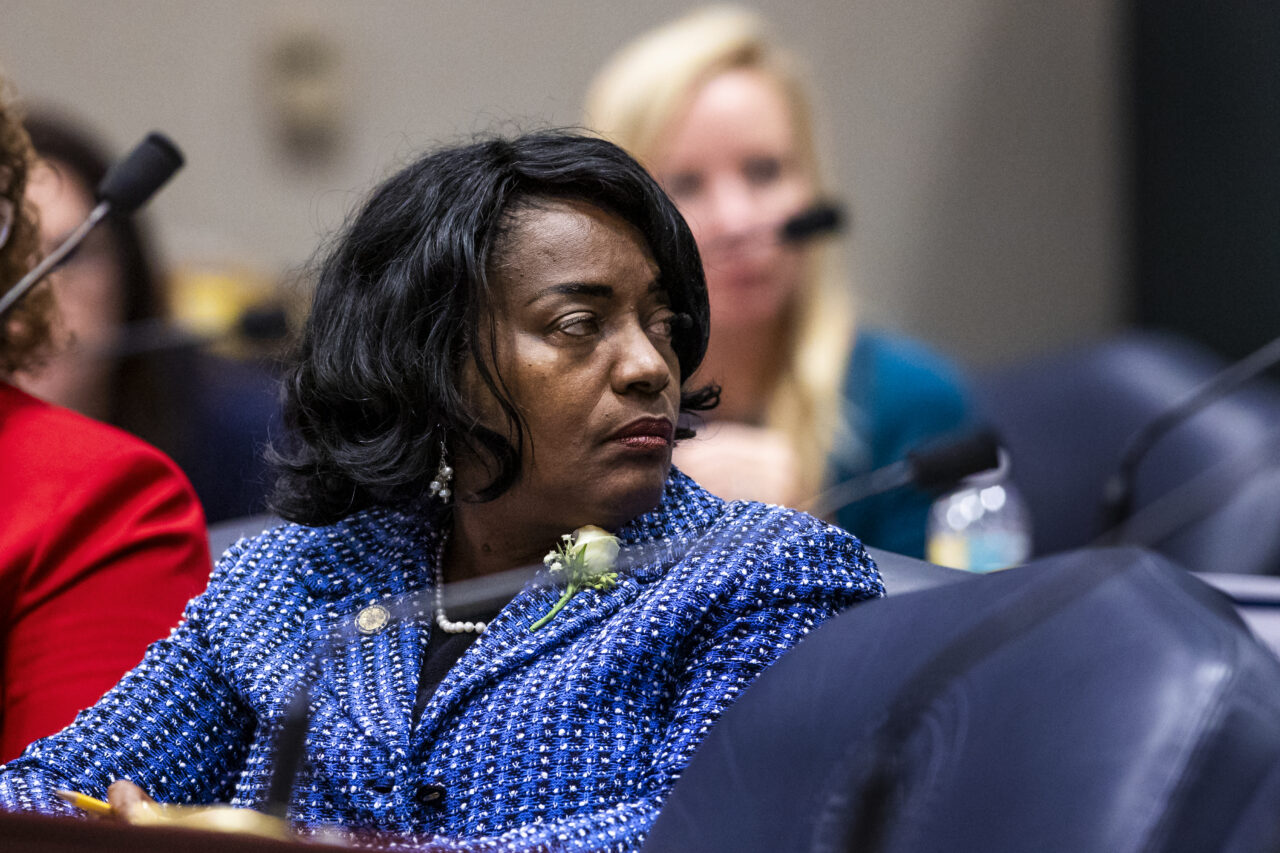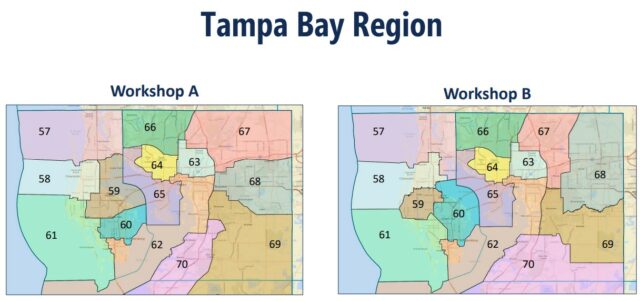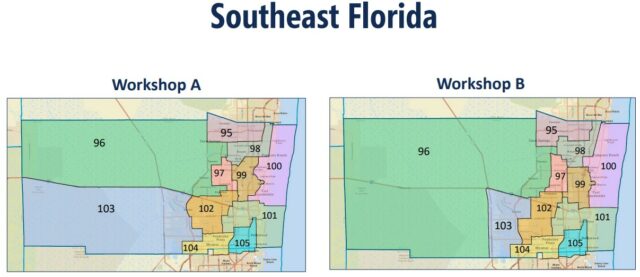
Is ensuring minority-controlled House districts don’t get diluted the same as protecting those communities’ voices? That’s the difficult-to-answer question underscoring the most viable tensions around draft House maps published this week.
Tampa Bay representatives questioned the need for a functional Black district to span parts of Hillsborough and Pinellas counties. A Haitian American House member questioned why Caribbean populations aren’t broken out as a subset of African Americans.
For the moment, House staff in drafting two workshop maps places a priority on racial minority-controlled districts, but with consciously less concern for “communities of interest,” areas connected culturally but not by a shared protection status under the federal Voting Rights Act.
Rep. Cord Byrd, the Neptune Beach Republican chairing the House Legislative Redistricting Subcommittee, stressed repeatedly at a Friday workshop that court rulings in the last decade made consideration of racial minorities a top-tier standard that must govern the cartography process. Communities like universities and military bases are not and will not be afforded the same stature.
But as lawmakers prepare for Session, there are clearly battles brewing as final jurisdictions begin literally to take shape.
Tampa Bay
The Tampa Bay region remains home to two House districts effectively controlled by Black voters, and two early House draft maps keep it that way. New districts 62 and 63, identical in both maps (H 8005 and H 8007), both include portions of Tampa.
But Rep. Dianne Hart, a Tampa Democrat, was shocked to see the proposed House District 62 cut from St. Petersburg across Tampa Bay to north of Interstate 4 in downtown Tampa. The district, most analogous to House District 70 on existing maps, cannot be navigated by car without driving out of the district. It also carves up the city of Tampa in ways undone in the House map approved a decade ago.
“We keep hearing about this city is kept whole and that city is kept whole,” she said. “When it came to Tampa, we split between Tampa and St. Petersburg and we also split down the middle of the community.”

Under the proposals, the new HD 62 sits adjacent to House District 63, with Broadway Avenue primarily providing the north border, but with parts of HD 62 reaching as far north as Ybor Heights. That means the district reaches into parts of the existing HD 61. One unspoken political consequence of that? The part of HD 61 shifted into the Bay-crossing district includes Hart’s home address.
That doesn’t mean an incumbent-on-incumbent situation because existing HD 70 Rep. Michele Rayner-Goolsby is running for Congress instead of seeking re-election. But if the maps were adopted as-is, it would leave Hart seeking support from a largely new constituency, and one where several St. Petersburg-based candidates are already campaigning for votes.
But beyond personal challenges, Hart raised concerns about why a minority community in Pinellas can’t be contained within the county lines, guaranteeing a Representative living on the same side of Tampa Bay. She urged staff to find a solution where the district wasn’t split by a bridge and leave a lawmaker representing “fish as opposed to people.”
Haitian voice
In South Florida, Rep. Marie Woodson, a Hollywood Democrat and Haitian American, questioned the focus exclusively on race in dividing lines. Ahead of the maps’ release, workshops went over the various legal standards governing the process.
“When we look at back community, was (there) any consideration on Caribbean community in Dade county? That’s something that is relevant looking at our state as a whole,” she said.

Byrd, though, said U.S. Census data identifies residents of the state as Black, but doesn’t break down subsets based on national origin. In that sense, a Haitian American neighborhood would be treated as a Black neighborhood but not as a separate community within it. That means the culturally connected community will be treated as a community of interest, something that can be taken into consideration by policymakers when drawing maps, but that is not a legally protected class where consideration must be made based on the guardrails created through court rulings.
He suggested to Woodson she work with staff on ways to address constituents’ concerns without running afoul of the priority legal bounds. “My recommendation is to address those concerns within the Tier 1 and Tier 2 standards,” he said.
Of note, the Tier 1 standards say maps cannot be drawn with the intention of “denying or abridging the equal opportunity of racial or language minorities.” Haiti’s official languages include French and Haitian Creole.
Black consideration
While staff for the Legislature has placed a high premium on not diluting minority community representation, there have been questions raised by Black lawmakers throughout the process about whether Black voters have been packed into districts. Just as Hart questioned if a separate Pinellas seat controlled by Black voters could exist absent Hillsborough, Sen. Randolph Bracy raised similar questions about Senate draft maps earlier this month.
It has created an odd dynamic during the once-a-decade process with staff insisting the highest priority has been placed on preventing any diminishment of power within Black communities, but some Black lawmakers asking if spreading voters out could create more power.
“Did staff have a situation where you had to pull out certain Black communities and put them in other districts?” asked Rep. Kevin Chambliss, a Homestead Democrat. He suggested there are cultural connections in some communities beyond race.
Leda Kelly, staff director for the House Redistricting Committee, said the goal in drafting maps was not so much “pushing and pulling” communities from existing districts as it was trying to create a holistic product that didn’t compromise the ability of minority communities to elect candidates of their choice.
Members in the workshop were encouraged to set time aside with staff to discuss the specific needs within their districts, matters those drawing boundaries from a distance won’t know immediately. But some members said that has been harder to schedule than it sounds. And some Democratic leaders have implied the voices of Black lawmakers have not been considered appropriately.
At a Thursday workshop of the House Congressional Redistricting Subcommittee, Rep. Kelly Skidmore, the ranking Democrat on the panel, questioned scheduling a meeting when many Black lawmakers were out of town. The National Black Caucus of State Legislators held its annual conference in Atlanta this week from Tuesday through Friday, and many members took early morning flights from Atlanta to Tallahassee to make it to the Friday workshop of the House Legislative Redistricting Subcommittee.



